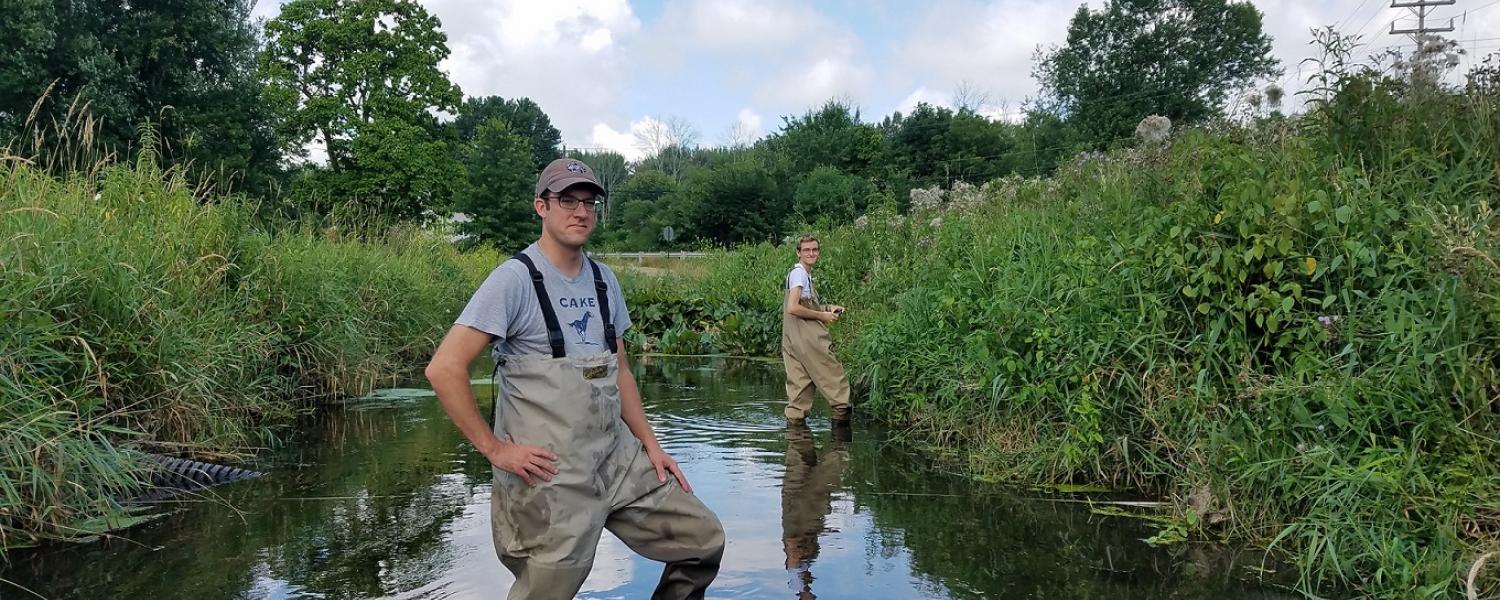şÚÁĎÍř’s David Costello, Ph.D., is passionate about identifying what trace metals lie within Northeast Ohio’s streams and what the effects of these metals are on the surrounding environment.
Costello, an associate professor in the Department of Biological Sciences, received a $718,000 grant from the National Science Foundation to study these important trace metals.
The grant is awarded as part of the National Science Foundation’s Faculty Early Career Development (CAREER) Program. The program supports early career development for researchers who have integrated education with their topics of research. For Costello, there is an ideal match up with his research and Kent State’s Upward Bound program, a federally-funded pre-college preparatory program within the Division of Diversity, Equity and Inclusion. The program targets high school students planning on attending college who are first-generation college students from low-income and underrepresented communities.
Costello’s research will focus on studying the part algal trace metals play in stream health and how they contribute to stream food systems.
“The major building blocks of algae are carbon, nitrogen and phosphorus and they have been studied in aquatic ecosystems for decades. Trace metals aren’t required in as high of an abundance but are also very critical to the nutrition of algae,” Costello said. “The theme is trying to understand the role that metals play in supporting the base of the food web in stream ecosystems.”
 Costello compared the trace metals in algae to the vitamins and minerals within a human diet.
Costello compared the trace metals in algae to the vitamins and minerals within a human diet.
“In human diets we care a lot about fat, protein and carbohydrates which are the building blocks of our nutrition,” Costello said. “But we have to think about other things like vitamins and minerals that come in smaller quantities but are still critically important to contribute to good nutrition.”
Algae is the foundation of the food web for many stream ecosystems, Costello explained, setting up the basics needed to nourish a variety of species.
“In streams that have any exposure to sunlight, algae are critically important. They are the base of the food web,” Costello said. “They start the food chain off and provide all the food that supports the invertebrates, bugs and insects, which eventually feed the fish.”
Costello is also interested in learning about how stream algae can affect aquatic habitats downstream, saying “algae have an ability to suck up nutrients and contaminants within our stream water...they have an important function in improving water quality.”
The specific trace metals Costello plans to study have roles in the nutrient cycling pathways.
“The nitrogen found in some fertilizers has to be converted to a different form before algae can incorporate it into new proteins and build new biomass” Costello said. “The enzyme that does that has a trace metal that is the active site where things happen.”
For example, to convert the nitrate to ammonium, the trace metal iron is used in algal enzymes as the conversion machine for that process. If there is an insufficient amount of iron in streams for algae to build conversion enzymes, the pollutants can move downstream and collect in lakes and cause algal blooms.
Costello’s collaboration with the Upward Bound program underscores the importance of interdisciplinary knowledge in STEM fields. “The program is focused on supporting the students who may not have a lot of family experience in college,” Costello said, “giving them structure and tools to help transition from high school to college.”
“I decided to focus on the importance of the interdisciplinary aspect of understanding and solving complex problems in science,” Costello said. “In order to understand what’s going on in streams you have to understand a little bit of geology, you have to understand a little bit of chemistry, and to understand the trace metals you have to dig into algal physiology.”
Costello explained that in STEM fields, one discipline is linked across several fields of study.
“It’s important for undergrads to understand that even if you're a biology major, even if you're a geology major, you are likely going to have to work in other fields and understand other fields to make transformative advances in science,” Costello said. “Where I think that can be most important is in the early stages of early education.”
In their initial years of college, STEM students take classes from all disciplines; biology majors take chemistry courses, and chemistry majors take math courses. Costello explained that getting students invested in these “required courses” is essential to their success in understanding complex science concepts.
“I’m working with the Upward Bound program to help develop some tools and techniques to help students see the bigger picture in why they are taking introductory classes across multiple departments,” Costello said.
More information on Kent’s Upward Bound Programs can be found here: /upwardboundprogram.
More information on Kent’s Center for Ecology and Natural Resource Sustainability can be found at: /esdri/center-ecology-natural-resource-sustainability.
Banner Image Caption: Dave Costello, Ph.D., (left), associate professor in şÚÁĎÍř’s Department of Biological Sciences in the College of Arts and Sciences, and Devan Mathie (right), an undergraduate honors student working in Dr. Costello’s lab, stand in Wahoo Ditch, a tributary to Breakneck Creek in Ravenna, Ohio.
Photo Caption: Andrea Fitzgibbon (Ph.D. student) and Nick Johnson (research technician) at work.
WRITTEN BY: COLLEEN CARROLL

